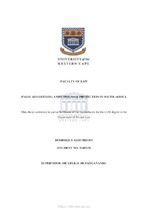| dc.description.abstract | Deceptive advertising, which is also known as false advertising, refers to a manufacturer making use of confusing, misleading, or blatantly untrue statements to promote a particular product or service. The phrase ‘false, misleading or deceptive’ was apparently adopted from North American legislation. It is important to begin by defining these key terms that are frequently used in this thesis. A ‘false’ representation means giving wrongful or incorrect information to someone. A ‘misleading’ representation can be defined as one that leads someone astray, or causes someone to have an incorrect impression or belief. A ‘deceptive’ representation is similar to a misleading representation because it is aimed at deceiving the consumer which ultimately leads to the consumer making an error in judgement. These terms are very similar to each other but there are subtle differences between them. Representations are often misleading or deceptive by virtue of it being false. A representation can, however, also be true yet still be misleading or deceptive. | en_US |

